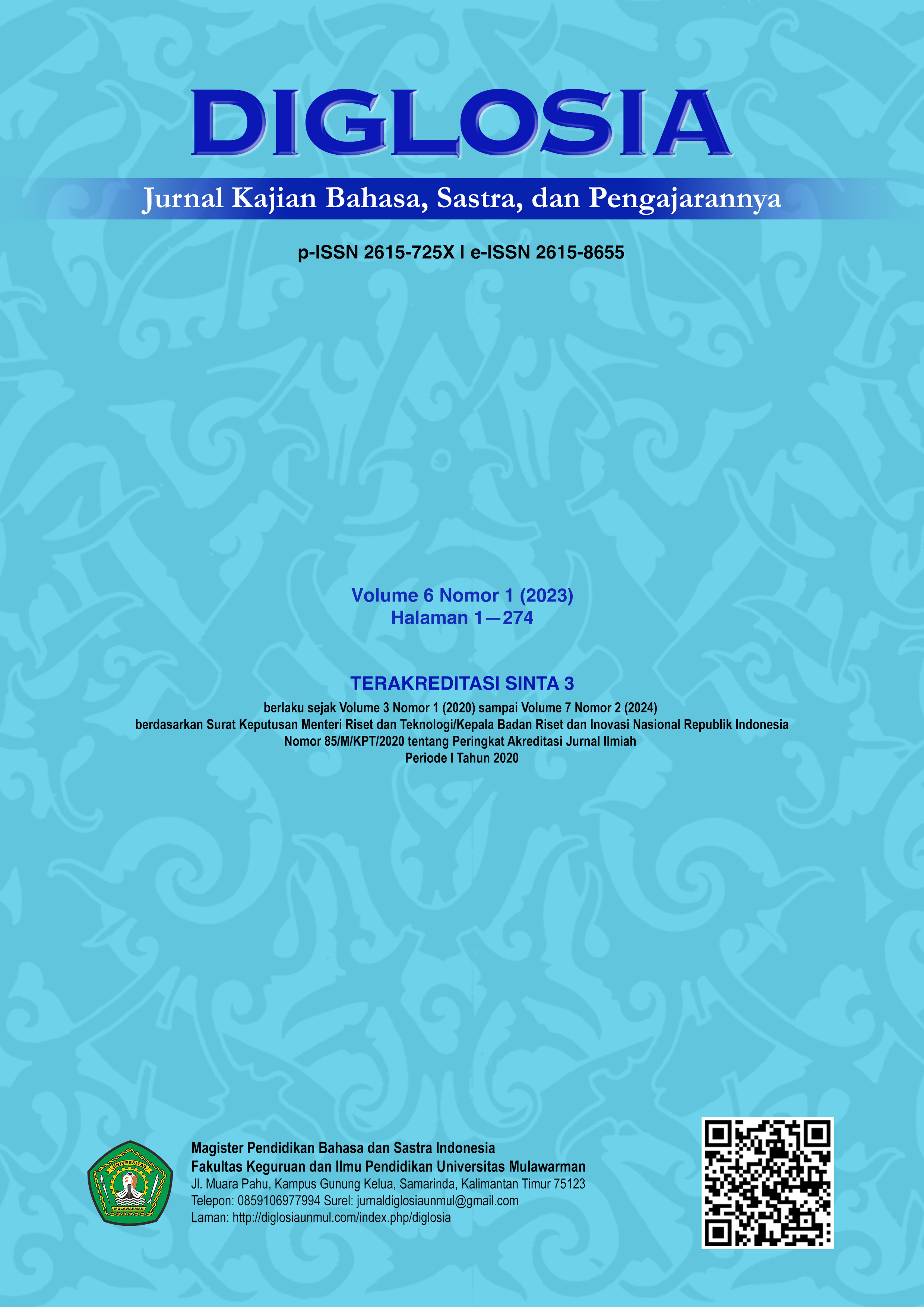Kesalahan Afiksasi dalam Caption Instagram @Infojember Edisi Oktober 2022
Main Article Content
Abstract
This study aims to describe affixation errors in the October 2022 edition of the Instagram @infojember social media caption. Qualitative research is the type of this research that uses a descriptive approach. The October 2022 edition of Instagram @infojember social media is the research data source. The data was used in the form of affixation errors that exist in the October 2022 edition of the @infojember caption. The reading and note-taking techniques were used in this research, namely by reading each caption critically; then, if it saw symptoms of affixation errors, it was recorded and grouped according to the indicators that had been made previously. The data analysis techniques by reducing data, presenting data, and drawing conclusions. The study's results found that there are still affixation errors in the October 2022 edition of Instagram @infojember social media, namely 15 errors, with details of 7 errors in prefix errors, 3 errors in suffix errors, and 5 errors in confix errors. The data found have the same types of errors, namely in the form of prefix omission, suffix omission, and confix omission.
Downloads
Article Details
![]()
Every work in Diglosia: Jurnal Kajian Bahasa, Sastra, dan Pengajarannya is licensed under a Creative Commons Attribution-ShareAlike 4.0 International License.
Under the following terms:
- Attribution — You must give appropriate credit , provide a link to the license, and indicate if changes were made . You may do so in any reasonable manner, but not in any way that suggests the licensor endorses you or your use.
- ShareAlike — If you remix, transform, or build upon the material, you must distribute your contributions under the same license as the original.
- No additional restrictions — You may not apply legal terms or technological measures that legally restrict others from doing anything the license permits.
Authors who publish with this journal agree to the following terms:
- Authors retain copyright and grant the journal right of first publication with the work simultaneously licensed under a CC BY-SA 4.0 DEED Attribution-ShareAlike 4.0 Internationalthat allows others to share the work with an acknowledgment of the work's authorship and initial publication in this journal.
- Authors are able to enter into separate, additional contractual arrangements for the non-exclusive distribution of the journal's published version of the work (e.g., post it to an institutional repository or publish it in a book), with an acknowledgment of its initial publication in this journal.
- Authors are permitted and encouraged to post their work online (e.g., in institutional repositories or on their website) prior to and during the submission process, as it can lead to productive exchanges, as well as earlier and greater citation of published work.
References
Hardyanti, S., Wagiran, & Utami, S. P. T. (2017). Perbandingan Afiks Pembentuk Verba Bahasa Indonesia dan Bahasa Jawa. Jurnal Sastra Indonesia, 6(1), 34–40. https://journal.unnes.ac.id/sju/index.php/jsi/article/view/17049
Hasanah, H., Setiawati, E., & Nurhayani, I. (2022). Afiksasi Verba Bahasa Madura Dialek Pamekasan berdasarkan Perspektif Derivasi dan Infleksi. Diglosia: Jurnal Kajian Bahasa, Sastra, Dan Pengajarannya, 5(3), 557–588. https://doi.org/10.30872/diglosia.v5i3.472
Herawati, R., Juansah, D. E., & Tisnasari, S. (2019). Analisis Afiksasi dalam Kata-Kata Mutiara Pada Caption di Media Sosial Instagram dan Implikasinya terhadap Pembelajaran Bahasa Indonesia di SMP. Jurnal Membaca Bahasa Dan Sastra Indonesia, 4(1), 45–50. https://jurnal.untirta.ac.id/index.php/jurnalmembaca/article/view/6236
Kaso, S. (2020). Analisis Kesalahan Morfologi dalam Menulis Teks Deskripsi Siswa Kkelas VII MTsN 1 Tulungagung. MARDIBASA: Jurnal Pembelajaran Bahasa Dan Sastra Indonesia, 1(1), 99–120. https://doi.org/10.21274/jpbsi.2021.1.1.99-120
Kridalaksana, H. (2010). Pembentukan Kata dalam Bahasa Indonesia. Gramedia Pustaka Utama.
Mansuri, M. H. (2022). Analisis Kesalahan Berbahasa dalam Tataran Morfologi pada Buku Lelaki Harapan Karya Siti Shofia Munawaroh. Peneroka:Jurnal Kajian Ilmu Pendidikan Bahasa Dan Sastra Indonesia, 2(2), 264–282. https://ejournal.iaida.ac.id/index.php/Peneroka/article/view/1570
Margiyanti, R., & Yuliyanto, A. (2021). Bahasa Slang dalam Akun Instagram @moodreceh.id. Bapala, 8(6), 164–176. https://ejournal.unesa.ac.id/index.php/bapala/article/view/42198
Nisa, A. K. A., Trisnawati, Y., & Prihatini, A. (2021). Tindak Tutur Ekspresif Tokoh dalam Novel Pulang-Pergi Karya Tere Liye. Mabasan, 15(2), 365–381. https://doi.org/10.26499/mab.v15i2.474
Nuryadin, T. R., & Nur, T. (2021). Metafora Konseptual Bertema Rihlah (Jalan-Jalan) pada Majalah Gontor: Analisis Semantik Kognitif. Diglosia: Jurnal Kajian Bahasa, Sastra, Dan Pengajarannya, 4(1), 91–100. https://doi.org/10.30872/diglosia.v4i1.72
Permatasari, N. E., Khasanah, I. M., & Putri, N. A. M. (2019). Kesalahan Berbahasa dalam Majalah Pandawa IAIN Surakarta Edisi 2018 pada Tataran Ejaan dan Sintaksis. Diglosia: Jurnal Kajian Bahasa, Sastra, Dan Pengajarannya, 2(2), 103–114. https://doi.org/10.30872/diglosia.v2i2.22
Putri, R. A., Muhyidin, A., & Tisnasari, S. (2020). Analisis Kesalahan Berbahasa pada Surat Resmi Organisasi Keluarga Besar Mahasiswa FKIP Untirta. Jurnal Bébasan, 7(1), 55–64. https://jurnalbebasan.kemdikbud.go.id/bebasan/index.php/home/article/view/101
Satiti, S. D., & Hendrokumoro, H. (2022). Penyimpangan Ortografi Bahasa Jawa pada Media Sosial Instagram. Diglosia: Jurnal Kajian Bahasa, Sastra, Dan Pengajarannya, 5(2), 437–452. https://doi.org/10.30872/diglosia.v5i2.341
Sulastri, A., Yunus MS, N. H., & Riniawati, R. (2020). Analisis Kesalahan Penggunaan Afiks dalam Makalah Mahasiswa Semester 1 Program Studi Pendidikan Bahasa Indonesia Universitas Al Asyariah Mandar. Pepatudzu : Media Pendidikan Dan Sosial Kemasyarakatan, 16(1), 51–60. https://doi.org/10.35329/fkip.v16i1.661
Yuniar, Y., Azizah, N., & Irma, C. N. (2020). Analisis Kesalahan Berbahasa Penulisan Surat Lamaran Pekerjaan Siswa SMK Al-Huda Bumiayu. Diglosia: Jurnal Kajian Bahasa, Sastra, Dan Pengajarannya, 3(2), 189–196. https://doi.org/10.30872/diglosia.v3i2.32

